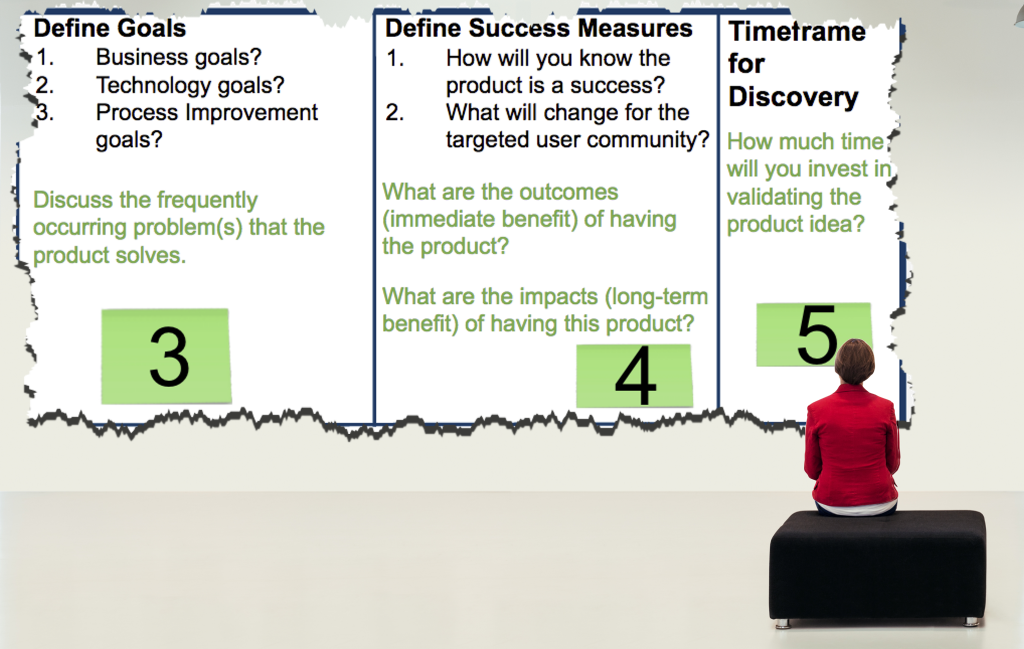Using the Product Discovery Canvas, Part 4: Goals, Success Measures, Timeframe for Discovery
 Fig 1. Product Discovery Canvas.
Fig 1. Product Discovery Canvas.
Ideally you’ve been following this blog series as we’ve engaged in product discovery for “Card Safe Zone” and you’re using the Product Discovery Canvas for your own product idea(s). So far we have written an “Elevator Pitch” and we’ve identified our potential Users and Customers. Next, we need to identify the product Goals and Success Measures. Also, we’ll establish the amount of time that we will commit to product discovery and validation. Now, let’s move our investigation into Discovery Boxes 3, 4 and 5 on the Product Discovery Canvas. Here we will answer questions to provide the team with valuable insights on determining if our product idea will result in the ideal product.
The first five boxes, encompassing the entire top row of the Product Discovery Canvas, entail the activities of Product Chartering. I coach that this discovery activity be collaborative, where the outcome is whole team shared understanding and alignment around the product being developed. Collaborative Product Chartering stands in marked contrast to traditional Project Chartering which is typically written by a single individual, often an analyst or project manager, and is delivery focused: risk, scope, objectives, and delineation of roles and responsibilities.
Discovery Box 3 – Define Goals
In Discovery Box 3, there are three questions that a product manager should have the team investigate:
- What are the business goals?
Card Safe Zone is a branded app for banks and credit card companies to show their security first mind-set. Additionally, revenue generation is a by-product of increased card usage.
- What are the technology goals?
Technology goals of Card Safe Zone are: i) instantaneous feedback on the safety of using credit or debit cards at an establishment, ii) safe use of credit and debit cards, iii) reduction of identity theft.
- What are the process improvement goals?
The Process Improvement goals of Card SafeZone are smart fraud prevention versus costly fraud mitigation. Before, if you were victim of debit card fraud, the compromised funds would remain on hold until the impact was investigated and resolved.
The frequently occurring problem(s) that Card Safe Zone solves are: promotes safe credit and debit card usage for on premises purchases; promotes a reduction in identity theft.
Discovery Box 4 – Define Success Measures
In Discovery Box 4, there are two questions that a product manager should have the team investigate:
- How will you know the product is a success?
- Identity theft is reduced
- Customers are able to obtain instantaneous feedback on the safety of using credit or debit cards at an establishment
- The product has a high take-up rate (customer adoption)
- What will change for the targeted user community?
- Consumers, concerned about credit / debit card safety, will be capable of making point-of-sale decisions that can prevent or limit the impacts of card fraud.
- Retailers can advertise the safety of their establishment to attract new business and increase business revenues.
- Banks and card issuers will benefit from being viewed as safety and security minded. Increased card use will result in increased revenues.
Outcomes, the immediate benefit, of having Card SafeZone are the capability of instantaneous consumer feedback on the safety of using credit or debit cards at an establishment; card fraud prevention.
Impacts, the long-term benefit, of having Card SafeZone are a measurable reduction in card fraud and identity theft.
Discovery Box 5 – Timeframe for Discovery
In Discovery Box 5, there is a single questions that a product manager should have the team investigate:
- How much time will the team invest on product discovery?
Shorter is definitely better! Keep in mind that this is product discovery not product development. So think in terms of the shortest time frame that you can obtain meaningful feedback on the viability of the product idea.
- We desire plausible feedback about the viability of Card SafeZone within one-month.
Deeper Dive
A common pattern that I see when coaching teams on product discovery is they jump directly into discussing solutions, “the how”. The canvas is a guide for teams to instead begin the discussion on “why”, “who” and “what”. And by using it, a team rapidly understands the focus during product discovery is to “identify not solve”. The Product Discovery Canvas provides opportunities for product teams to leave an initial discovery meeting capable of telling the product story and having a shared understanding of the plan to “Build the right thing, the right way”.
The activity of Collaborative Chartering is thoughtfully examined by David Hussman in his free video series — Cutting an Agile Groove.
Examples
Download the current Card SafeZone canvas: Product Discovery Canvas for Card SafeZone.
Next Post …
The next post continues using the Product Discovery Canvas for product discovery on “Card SafeZone” and moves into Discovery Box 6 where we “Tell Stories About the Product”. See you next post.